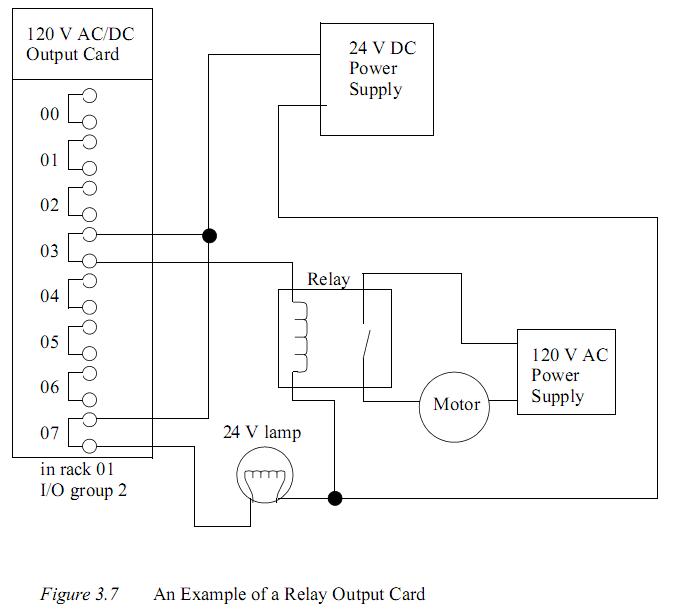3.2.2 Output Modules
3.2.2输出模块
WARNING - ALWAYS CHECK RATED VOLTAGES AND CURRENTS FOR PLC’s AND NEVER EXCEED!
警告-经常检查PLC的额定电压和电流绝不能超过!
正如输入模块,输出模块很少提供任何电力,而是作为开关。外部电源连接到输出卡,输出卡将为每个输出切换电源开或关。典型的输出电压在下面列出,并大致按常用顺序排列。
120 Vac
24 Vdc
12-48 Vac
12-48 Vdc
5Vdc (TTL)
230 Vac
These cards typically have 8 to 16 outputs of the same type and can be purchased with different current ratings. A common choice when purchasing output cards is relays, transistors or triacs. Relays are the most flexible output devices. They are capable of switching both AC and DC outputs. But, they are slower (about 10ms switching is typical), they are bulkier, they cost more, and they will wear out after millions of cycles. Relay outputs are often called dry contacts. Transistors are limited to DC outputs, and Triacs are limited to AC outputs. Transistor and triac outputs are called switched outputs.
这些卡通常有8至16个相同类型的输出,可以买到不同的额定电流。当购买输出卡时,一种常见的选择是继电器输出,晶体管或可控硅。继电器是最灵活的输出设备。他们能够开关交流和直流输出。但是,他们会更慢(典型的切换值约为10ms),他们体积较大,费用更高,而且会在数百万周期后报废。继电器输出通常被称为干节点。晶体管局限于直流输出,可控硅局限于于交流输出。晶体管和可控硅输出称为切换输出。
Dry contacts - a separate relay is dedicated to each output. This allows mixed voltages (AC or DC and voltage levels up to the maximum), as well as isolated outputs to protect other outputs and the PLC. Response times are often greater than 10ms. This method is the least sensitive to voltage variations and spikes.
干节点-一个独立的继电器,用于每个输出。允许混合电压(AC或DC,电压等级可至最高),也能隔离输出以保护其他输出和PLC。响应时间往往大于10毫秒。此方法用于对电压变化和尖峰不敏感。
Switched outputs - a voltage is supplied to the PLC card, and the card switches it to different outputs using solid state circuitry (transistors, triacs, etc.) Triacs are well suited to AC devices requiring less than 1A. Transistor outputs use NPN or PNP transistors up to 1A typically. Their response time is well under 1ms.
切换输出-电压提供给PLC的卡,卡切使用固态电路(晶体管,晶闸管等)换到不同的输出。可控硅适合于小于1A的交流设备。晶体管输出使用NPN或PNP晶体管一般高达1A。它们的响应时间大大低于1毫秒。
ASIDE: PLC outputs must convert the 5Vdc logic levels on the PLC data bus to external voltage levels. This can be done with circuits similar to those shown below. Basically the circuits use an optocoupler to switch external circuitry. This electrically isolates the external electrical circuitry from the internal circuitry. Other circuit components are used to guard against excess or reversed voltage polarity.
例外:PLC的输出必须在PLC的数据总线上把5Vdc的逻辑电平转换为外部的电压等级。这可以与如下的电路类似。基本上电路使用光耦电路切换外部电路。这从电气上隔绝了外部电路和内部的电路。其他电路组件是用来防止过压或翻转电压极性。
Caution is required when building a system with both AC and DC outputs. If AC is accidentally connected to a DC transistor output it will only be on for the positive half of the cycle, and appear to be working with a diminished voltage. If DC is connected to an AC triac output it will turn on and appear to work, but you will not be able to turn it off without turning off the entire PLC.
当建立一个既有交流又有直流输出的系统时需要注意。如果交流是意外连接到直流晶体管的输出,它将在正极的一半循环导通,似乎在减和旋电压周期工作。如果直流连接到一个交流可控硅输出,它将导通并似乎在工作,但你如果不把整个PLC关掉时不能使它截止。
ASIDE: A transistor is a semiconductor based device that can act as an adjustable valve. When switched off it will block current flow in both directions. While switched on it will allow current flow in one direction only. There is normally a loss of a couple of volts across the transistor. A triac is like two SCRs (or imagine transistors) connected together so that current can flow in both directions, which is good for AC current. One major difference for a triac is that if it has been switched on so that current flows, and then switched off, it will not turn off until the current stops flowing. This is fine with AC current because the current stops and reverses every 1/2 cycle, but this does not happen with DC current, and so the triac will remain on.
例外:晶体管是一个以半导体为基础的设备,它可以起调节电压值的作用。当关断时,它将在两个方向阻止电流流过。当接通时它将允许电流在一个方向流动。通常有一对电压通过晶体管。可控硅是两个可控硅整流器(或想象的晶体管)相连,这样使电流可以双向流动,这对交流电是很好的。其中可控硅的主要区别在于,如果它接通,电流将流过,然后关断,它不会关闭,直到电流停止流动。这对交流电是很好的,因为电流每1 / 2周期将停止并翻转,但对于直流电不起作用,因此可控硅将保持。
A major issue with outputs is mixed power sources. It is good practice to isolate all power supplies and keep their commons separate, but this is not always feasible. Some output modules, such as relays, allow each output to have its own common. Other output cards require that multiple, or all, outputs on each card share the same common. Each output card will be isolated from the rest, so each common will have to be connected. It is common for beginners to only connect the common to one card, and forget the other cards - then only one card seems to work!
一个主要问题是混合电源。习惯做法是隔离所有电源并保持其公共地独立,但这并不总是可行。一些输出模块,如继电器,允许每个输出有自己的公共地。其他输出卡需要多个或所有的输出共享彼此的公共地。每个输出卡和其余的卡是隔离的,所以每个公共地将必须连接。它是初学者共性问题,一般只连接一个卡到公共地,而忘记了其他卡 -那么只有一个卡似乎在工作!
The output card shown in Figure 3.5 is an example of a 24Vdc output card that has a shared common. This type of output card would typically use transistors for the outputs.
输出卡如图3.5所示,是一个24V直流电输的例子,有一个共享的公共地。这种类型的输出卡将通常用于晶体管输出。
In this example the outputs are connected to a low current light bulb (lamp) and a relay coil. Consider the circuit through the lamp, starting at the 24Vdc supply. When the output 07 is on, current can flow in 07 to the COM, thus completing the circuit, and allowing the light to turn on. If the output is off the current cannot flow, and the light will not turn on. The output 03 for the relay is connected in a similar way. When the output 03 is on, current will flow through the relay coil to close the contacts and supply 120Vac to the motor. Ladder logic for the outputs is shown in the bottom right of the figure. The notation is for an Allen Bradley ControlLogix. The output card (’O’) is in a rack labelled ’sue’ in slot 2. As indicated for the input card, it is good practice to define and use an alias tag for an output (e.g. Motor) instead of using the full description (e.g. sue:2.O.Data.3).
在这个例子中,输出连接到一个低电流灯泡(灯)和继电器线圈。把它看成在24Vdc的电源端开始,电流通过灯泡。当输出07接通,电流能够从07流到COM端,从而完成了电路,并使灯泡打开。如果输出是关闭的,电流不能流通,灯泡也不会点亮。给继电器的输出03以类似的方式连接。当输出03 ON,电流将流过继电器线圈闭合触点,给120Vac的马达供电。输出的梯形逻辑显示在右下角的图中。是ControlLogix A-B的标记。输出卡(O)是在标记为'SUE'的机架的插槽2。至于输入卡的表示,为一个输出定义和使用标签的别名(如汽车)是很好的做法,而不是使用完整的描述(如sue:2.O.Data.3)。
这个卡可以根据不同的电源应用于许多不同的电压,但所有的电源需要一个单独的共同的公共地。
图3.6电路有一组电源,然后是设备,然后是PLC的卡,然后是电源。这就需要输出卡有一个公共地。一些输出电路翻转设备和PLC卡,从而取代了带电压输入的公共地。图3.5中的例子也出现在图3.6的电压卡。

We can also use relay outputs to switch the outputs. The example shown in Figure 3.5 and Figure 3.6 is repeated yet again in Figure 3.7 for relay output.
在这个例子中,24Vdc的正极端子直接连接到了输出卡。当输出闭合,电源将供给它的输出。例如,如果输出07闭合,则电源电压将输出到灯。电流将流经灯,回到电源上的公共地。这个操作非常相似于用继电器切换电机。请注意,梯形逻辑(在图的右下方显示)和图3.5是完全相同的。在这样的输出卡,只有一种类型电源可以使用。
我们还可以使用继电器输出来切换输出。如图3.5所示的例子和图3.6、图3.7再次重复继电器输出。

在这个例子中,24Vdc电源直接连接到两个继电器(注意,现在需要2个连接点,而前面的例子只需要一个。)当输出激活,输出开关闭合,电源被传递到输出设备。 这种布局更类似于图3.6带输出电压,但继电器也可以用来连接输出到地,如图3.5所示。当使用继电器输出,它有可能有一个独立于其它的输出。继电器输出卡在彼此的旁边可以有交流和直流输出。


























 1006
1006

 被折叠的 条评论
为什么被折叠?
被折叠的 条评论
为什么被折叠?








